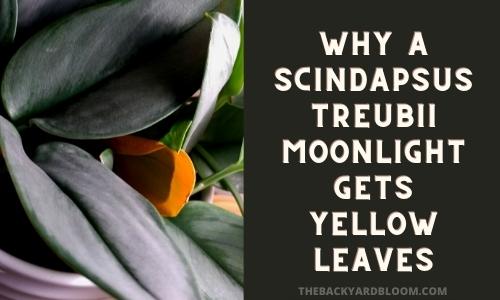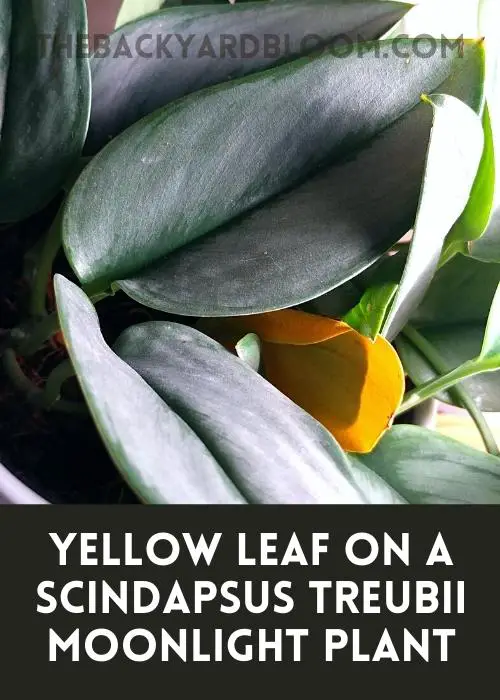Scindapsus Treubii Moonlight plants are known for their thick green and silver leaves. When the colors of these leaves start changing that can be alarming for many who have Scindapsus plants.
Often times plant owners find yellow leaves on their plants. It is not an uncommon thing to see, especially when you get a new plant. Sometimes this can indicate watering or drainage problems. In this article, we go over why a Scindapsus Treubii Moonlight would get yellow leaves and what can be done to prevent this from happening.

Check out our Guide for Scindapsus Treubii Moonlight Care for more information on how to care for your plant.
Scindapsus Treubii Moonlight Leaves Turning Yellow
Most often finding the leaves on a Scindapsus Treubii Moonlight starting to turn yellow will indicate that there has been too much water in the soil for the plant.
Yellow Leaves Due to Overwatering
Overwatering is a common problem with Scindapsus Treubii Moonlight plants. Especially if you have just picked your’s up from a big box store.
The Scindapsus with a yellow leaf in the picture below is from the plant sitting in soggy soil and parts of the roots started to get root rot. This appeared about a week after getting it from a big box store. Often in these stores, all of the plants are drenched daily in water and are sitting in soggy soil due to a combination of no drainage in the pots and the soil medium they are in. The one that I had this issue with was in peat-based soil without much perlite and had Sphagnum Moss covering the soil. This combination added to the abundant moisture in the soil.

If there are only one or two yellow leaves on the plant you usually don’t have to do much to the plant other than removing the yellow leaves and cutting back on how much and often you are watering the plant. Let the top few inches of the soil dry completely between watering.
If root rot has not set in you should not see any more leaves turning yellow on your plant. However if more yellow leaves start to appear then this could be an indication that root rot has begun and you will have to do some more to help save the plant.
Helping a Scindapsus Treubii with Root Rot
In order to combat this, you need to remove the plant from its pot and get as much of the soil off of the roots as you can. Inspect the roots to see if any root rot has occurred. If you see roots that are darker than the others and have a mushy feel to them remove them with some sharp shears or scissors. Also, go ahead and remove the leaves that have completely turned yellow at this time.
If your pot does not have any drainage then you will want to get a new pot to put your plant in that allows for the excess water to drain from the pot.
Get new soil to put your plant in, you don’t have to be too particular with the soil. A peat-based soil is fine, but add some extra perlite or vermiculite to the mixture to help the soil drain well.
Put your plant back in the pot with the new soil. Pay attention to the soil moisture levels after this as you determine how often your Scindapsus needs to be watered. Let the top few inches of soil dry out before you water the plant again.
Bottom watering is a great option for Scindapsus Treubii plants, this allows the plant to take up what it needs and can help combat overwatering.
Yellow Leaves with Black Spots
If you see black spots on the leaves that have turned yellow then this could be a case of mold developing.
Mold can develop on Scindapsus Truebii Moonlight plants when they have been kept in a more humid area and then get placed in a dark location. Mold thrives in dark and damp conditions.
To try and combat this it is best to put your Scindapsus Treubii in a location that has good airflow (but not in a direct draft) and has indirect light.
Remove the leaves that have the mold and change how you water your Scindapsus. Water from the bottom by sitting the pot in a tray of water for a few hours to allow the plant to take up what it needs. Do not water the plant again until the soil has dried out mostly.
The key to helping the plant with mold is to prevent the mold from spreading and not to have the plant in conditions that are favorable for mold growth.
Too Much Humidty
Yellowing leaves can also be an indication that there is too much humidity for the plant. Optimal humidity for these plants is between 40% and 60%. They can often go lower than 40% and be ok, but going above the 60% mark can cause issues and one indication is yellowing leaves.
TL;DR for a Scindapsus Treubii Moonlight With Yellow Leaves
- Most often due to overwatering.
- Cut back on watering and watch for too high of humidity (over 60%)
- Allow soil to dry in the top few inches between watering.
- Repot and check for root rot if cutting back on water does not fix the issue.
- If there are black spots on the yellow leaves then this indicates mold. Put the plant in lower humidity, indirect light, and allow for good airflow.